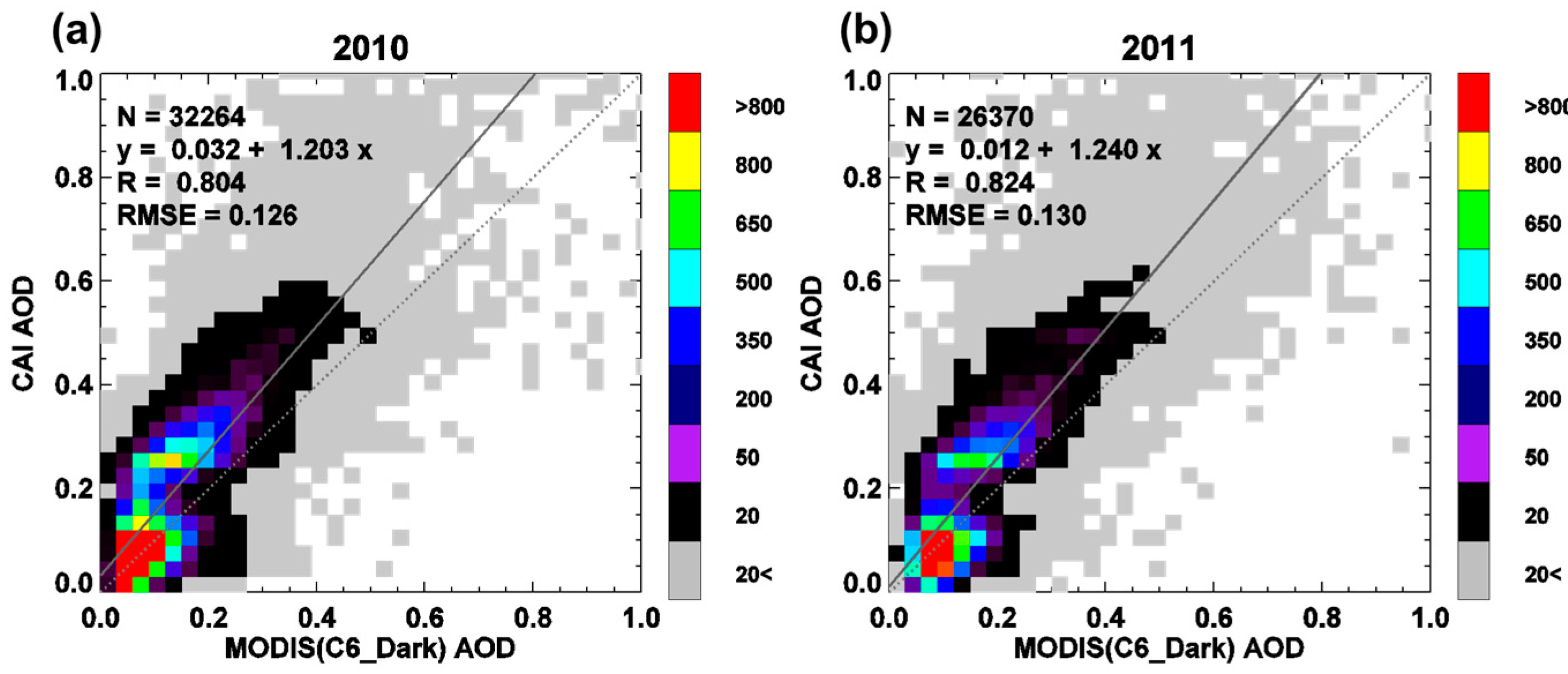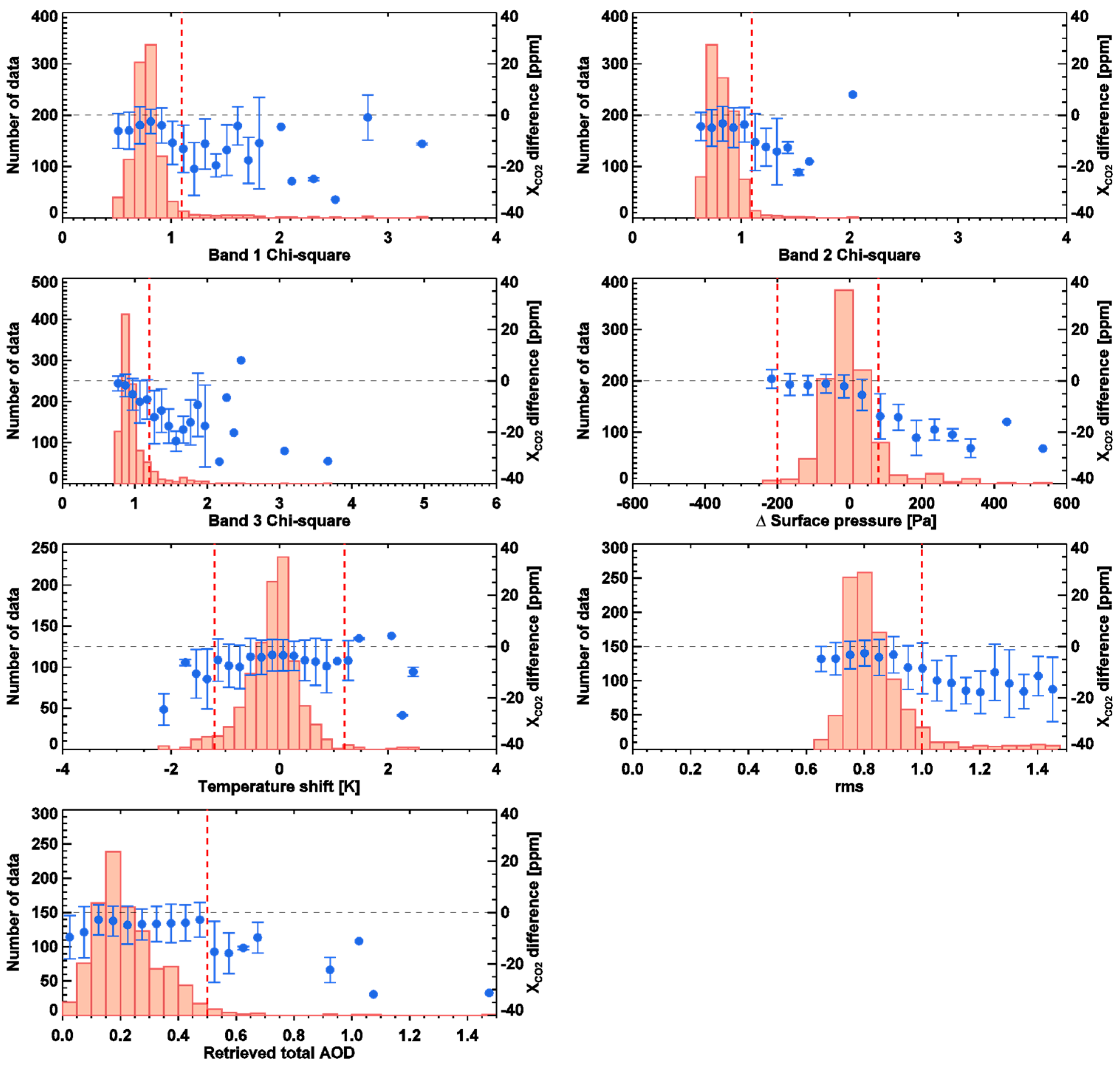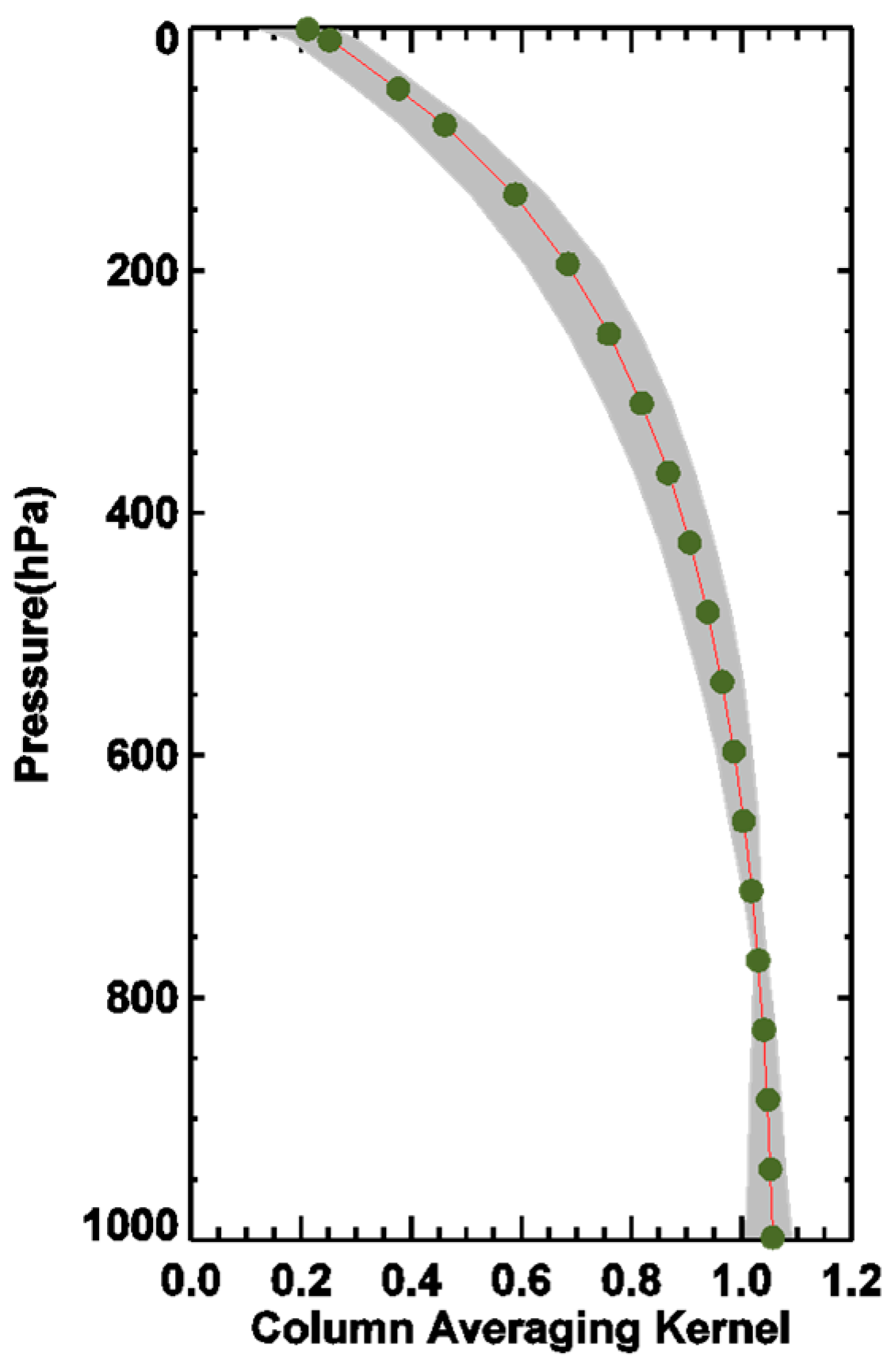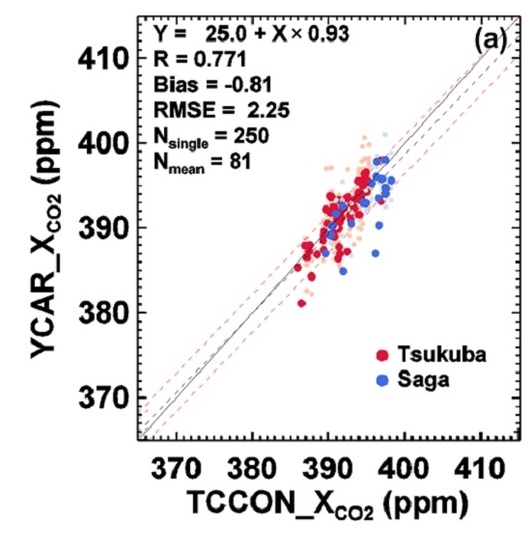Retrieving XCO2 from GOSAT FTS over East Asia Using Simultaneous Aerosol Information from CAI
Abstract
:1. Introduction
2. CO2 Retrieval Algorithm
2.1. GOSAT Instruments
2.2. Retrieval Algorithm
2.3. Forward Model
2.4. State Vectors and Input Data
2.5. CAI Aerosol Algorithm
3. Data
3.1. TCCON
3.2. GOSAT Retrieval
4. Results and Discussion
5. Summary and Conclusions
Acknowledgments
Author Contributions
Conflicts of Interest
References
- Intergovernmental Panel on Climate Change (IPCC). Climate Change 2014: Synthesis Report. Contribution of Working Groups I, II and III to the Fifth Assessment Report of the Intergovernmental Panel on Climate Change; IPCC: Geneva, Switzerland, 2014. [Google Scholar]
- Masarie, K.A.; Tans, P.P. Extension and integration of atmospheric carbon-dioxide data into a globally consistent measurement record. J. Geophys. Res. Atmos. 1995, 100, 11593–11610. [Google Scholar] [CrossRef]
- Solomon, S.; Intergovernmental Panel on Climate Change; Intergovernmental Panel on Climate Change, Working Group I. Climate Change 2007: The Physical Science Basis: Contribution of Working Group I to the Fourth Assessment Report of the Intergovernmental Panel on Climate Chang; Cambridge University Press: Cambridge, UK; New York, NY, USA, 2007; p. 996. [Google Scholar]
- Jones, N. Troubling milestone for CO2. Nat. Geosci. 2013, 6, 589. [Google Scholar] [CrossRef]
- Wigley, T.M.L. The pre-industrial carbon-dioxide level. Clim. Chang. 1983, 5, 315–320. [Google Scholar] [CrossRef]
- Schmidt, H.; Alterskjaer, K.; Karam, D.B.; Boucher, O.; Jones, A.; Kristjansson, J.E.; Niemeier, U.; Schulz, M.; Aaheim, A.; Benduhn, F.; et al. Solar irradiance reduction to counteract radiative forcing from a quadrupling of CO2: Climate responses simulated by four earth system models. Earth Syst. Dyn. 2012, 3, 63–78. [Google Scholar] [CrossRef] [Green Version]
- Keeling, C.D. The concentration and isotopic abundances of carbon dioxide in the atmosphere. Tellus 1960, 12, 200–203. [Google Scholar] [CrossRef]
- World Meteorological Organization (WMO). Strategy for the Implementation of the Global Atmosphere Watch Programme (2001–2007), a Contribution to the Implementation of the WMO Long-Term Plan; WMO: Geneva, Switzeland, 2001. [Google Scholar]
- World Meteorological Organization (WMO). World Data Center for Greenhouse Gases (WDCGG) Data Summary; WDCGG: Tokyo, Japan, 2012. [Google Scholar]
- Conway, T.; Lang, P.; Masarie, K. Atmospheric Carbon Dioxide Dry Air Mole Fractions from the Noaa Esrl Carbon Cycle Cooperative Global Air Sampling Network, 1968–2006, Version: 2007–09–19. Available online: https://www.ftp.cmdl.noaa.gov/ccg/co2/flask/event (accessed on 30 November 2016).
- Conway, T.; Tans, P.P.; Waterman, L.; Thoning, K.; Kitzis, D.; Masarie, K.; Zhang, N. Evidence for interannual variability of the carbon cycle from the noaa/cmdl global air sampling network. J. Geophys. Res. 1994, 99, 22831–22855. [Google Scholar] [CrossRef]
- Hungershoefer, K.; Breon, F.M.; Peylin, P.; Chevallier, F.; Rayner, P.; Klonecki, A.; Houweling, S.; Marshall, J. Evaluation of various observing systems for the global monitoring of CO2 surface fluxes. Atmos. Chem. Phys. 2010, 10, 10503–10520. [Google Scholar] [CrossRef]
- Gurney, K.R.; Law, R.M.; Denning, A.S.; Rayner, P.J.; Baker, D.; Bousquet, P.; Bruhwiler, L.; Chen, Y.H.; Ciais, P.; Fan, S.; et al. Towards robust regional estimates of CO2 sources and sinks using atmospheric transport models. Nature 2002, 415, 626–630. [Google Scholar] [CrossRef] [PubMed]
- Yokota, T.; Yoshida, Y.; Eguchi, N.; Ota, Y.; Tanaka, T.; Watanabe, H.; Maksyutov, S. Global concentrations of CO2 and ch4 retrieved from GOSAT: First preliminary results. Sola 2009, 5, 160–163. [Google Scholar] [CrossRef]
- Crisp, D. Measuring atmospheric carbon dioxide from space with the orbiting carbon observatory-2 (oco-2). In SPIE Optical Engineering+ Applications; International Society for Optics and Photonics: Bellingham, WA, USA, 2015; pp. 960702–960707. [Google Scholar]
- Kuze, A.; Suto, H.; Nakajima, M.; Hamazaki, T. Thermal and near infrared sensor for carbon observation fourier-transform spectrometer on the greenhouse gases observing satellite for greenhouse gases monitoring. Appl. Opt. 2009, 48, 6716–6733. [Google Scholar] [CrossRef] [PubMed]
- Yoshida, Y.; Ota, Y.; Eguchi, N.; Kikuchi, N.; Nobuta, K.; Tran, H.; Morino, I.; Yokota, T. Retrieval algorithm for CO2 and CH4 column abundances from short-wavelength infrared spectral observations by the greenhouse gases observing satellite. Atmos. Meas. Tech. 2011, 4, 717–734. [Google Scholar] [CrossRef]
- Connor, B.J.; Boesch, H.; Toon, G.; Sen, B.; Miller, C.; Crisp, D. Orbiting carbon observatory: Inverse method and prospective error analysis. J. Geophys. Res. Atmos. 2008, 113. [Google Scholar] [CrossRef]
- Crisp, D.; Fisher, B.M.; O’Dell, C.; Frankenberg, C.; Basilio, R.; Bosch, H.; Brown, L.R.; Castano, R.; Connor, B.; Deutscher, N.M.; et al. The acos CO2 retrieval algorithm—Part ii: Global x-CO2 data characterization. Atmos. Meas. Tech. 2012, 5, 687–707. [Google Scholar] [CrossRef]
- O’Dell, C.W.; Connor, B.; Bosch, H.; O’Brien, D.; Frankenberg, C.; Castano, R.; Christi, M.; Crisp, D.; Eldering, A.; Fisher, B.; et al. The acos CO2 retrieval algorithm—Part 1: Description and validation against synthetic observations. Atmos. Meas. Tech. 2012, 5, 99–121. [Google Scholar] [CrossRef]
- Boesch, H.; Baker, D.; Connor, B.; Crisp, D.; Miller, C. Global characterization of CO2 column retrievals from shortwave-infrared satellite observations of the orbiting carbon observatory-2 mission. Remote Sens. 2011, 3, 270–304. [Google Scholar] [CrossRef]
- Butz, A.; Hasekamp, O.P.; Frankenberg, C.; Aben, I. Retrievals of atmospheric CO2 from simulated space-borne measurements of backscattered near-infrared sunlight: Accounting for aerosol effects. Appl. Opt. 2009, 48, 3322–3336. [Google Scholar] [CrossRef] [PubMed]
- Saitoh, N.; Imasu, R.; Ota, Y.; Niwa, Y. CO2 retrieval algorithm for the thermal infrared spectra of the greenhouse gases observing satellite: Potential of retrieving CO2 vertical profile from high-resolution fts sensor. J. Geophys. Res. Atmos. 2009, 114. [Google Scholar] [CrossRef]
- Oshchepkov, S.; Bril, A.; Yokota, T.; Morino, I.; Yoshida, Y.; Matsunaga, T.; Belikov, D.; Wunch, D.; Wennberg, P.; Toon, G.; et al. Effects of atmospheric light scattering on spectroscopic observations of greenhouse gases from space: Validation of ppdf-based CO2 retrievals from gosat. J. Geophys. Res. Atmos. 2012, 117. [Google Scholar] [CrossRef]
- Frankenberg, C.; Platt, U.; Wagner, T. Iterative maximum a posteriori (imap)-doas for retrieval of strongly absorbing trace gases: Model studies for CH4 and CO2 retrieval from near infrared spectra of sciamachy onboard envisat. Atmos. Chem. Phys. 2005, 5, 9–22. [Google Scholar] [CrossRef]
- O’Brien, D.M.; Rayner, P.J. Global observations of the carbon budge—2. CO2 column from differential absorption of reflected sunlight in the 1.61 mu m band of CO2. J. Geophys. Res. Atmos. 2002, 107. [Google Scholar] [CrossRef]
- Takemura, T.; Okamoto, H.; Maruyama, Y.; Numaguti, A.; Higurashi, A.; Nakajima, T. Global three-dimensional simulation of aerosol optical thickness distribution of various origins. J. Geophys. Res. Atmos. 2000, 105, 17853–17873. [Google Scholar] [CrossRef]
- ESA Greenhouse Gas-Climate Change Initiative (GHG-CCI). Algorithm Theoretical Basis Document Version 3 (atbdv3)—The University of Leicester Fullphysics Retrieval Algorithm for the Retrieval of xCO2 and xCH4; ESA Greenhouse Gas-Climate Change Initiative (GHG-CCI): Paris, France, 2014; pp. 1–28. [Google Scholar]
- Boesch, H.; Vogel, L.; Hewson, W.; Parker, R.; Somkuti, P.; Sembhi, H.; Webb, A. An Improved Aerosol Scheme for the GHG Retrieval from GOSAT. In Proceedings of the 12th International Workshop on Greenhouse Gas Measurements from Space, Kyoto, Japan, 7–9 June 2016.
- Kuze, A.; Urabe, T.; Suto, H.; Kaneko, Y.; Hamazaki, T. The instrumentation and the BBM test results of thermal and near-infrared sensor for carbon observation (TANSO) on GOSAT. In SPIE Optics+ Photonics; International Society for Optics and Photonics: Bellingham, WA, USA, 2006; pp. 62970K–62978K. [Google Scholar]
- Kuang, Z.M.; Margolis, J.; Toon, G.; Crisp, D.; Yung, Y. Spaceborne measurements of atmospheric CO2 by high-resolution nir spectrometry of reflected sunlight: An introductory study. Geophys. Res. Lett. 2002, 29. [Google Scholar] [CrossRef]
- Boesche, E.; Stammes, P.; Bennartz, R. Aerosol influence on polarization and intensity in near-infrared o-2 and CO2 absorption bands observed from space. J. Quant. Spectrosc. Radiat. Transf. 2009, 110, 223–239. [Google Scholar] [CrossRef]
- Houweling, S.; Hartmann, W.; Aben, I.; Schrijver, H.; Skidmore, J.; Roelofs, G.J.; Breon, F.M. Evidence of systematic errors in sciamachy-observed CO2 due to aerosols. Atmos. Chem. Phys. 2005, 5, 3003–3013. [Google Scholar] [CrossRef] [Green Version]
- Mao, J.P.; Kawa, S.R. Sensitivity studies for space-based measurement of atmospheric total column carbon dioxide by reflected sunlight. Appl. Opt. 2004, 43, 914–927. [Google Scholar] [CrossRef] [PubMed]
- Rodgers, C.D. Inverse Methods for Atmospheric Sounding: Theory and Practice; World Scientific: Singapore, 2000; Volume 2. [Google Scholar]
- Jung, Y.; Kim, J.; Kim, W.; Boesch, H.; Lee, H.; Cho, C.; Goo, T.Y. Impact of aerosol property on the accuracy of a CO2 retrieval algorithm from satellite remote sensing. Remote Sens. 2016, 8, 20. [Google Scholar] [CrossRef]
- Levenberg, K. A method for the solution of certain non–linear problems in least squares. 1944, 2, 164–168. [Google Scholar]
- Marquardt, D.W. An algorithm for least-squares estimation of nonlinear parameters. J. Soc. Ind. Appl. Math. 1963, 11, 431–441. [Google Scholar] [CrossRef]
- Spurr, R.J.D. Vlidort: A linearized pseudo-spherical vector discrete ordinate radiative transfer code for forward model and retrieval studies in multilayer multiple scattering media. J. Quant. Spectrosc. Radiat. Transf. 2006, 102, 316–342. [Google Scholar] [CrossRef]
- Bodhaine, B.A.; Wood, N.B.; Dutton, E.G.; Slusser, J.R. On Rayleigh optical depth calculations. J. Atmos. Ocean. Tech. 1999, 16, 1854–1861. [Google Scholar] [CrossRef]
- Tran, H.; Hartmann, J.M. An improved o-2 a band absorption model and its consequences for retrievals of photon paths and surface pressures. J. Geophys. Res. Atmos. 2008, 113. [Google Scholar] [CrossRef]
- Toon, G.C.; Blavier, J.F.; Sen, B.; Salawitch, R.J.; Osterman, G.B.; Notholt, J.; Rex, M.; McElroy, C.T.; Russell, J.M. Ground-based observations of arctic o-3 loss during spring and summer 1997. J. Geophys. Res. Atmos. 1999, 104, 26497–26510. [Google Scholar] [CrossRef]
- Lee, S.; Kim, J.; Kim, M.; Choi, M.; Go, S.; Lim, H.; Goo, T.; Tatsuya, Y. Development of aerosol retrieval algorithm over East Asia from TANSO-CAI measurements onboard GOSAT. Unpublished work. 2017. [Google Scholar]
- Higurashi, A.; Nakajima, T. Detection of aerosol types over the East China Sea near Japan from four-channel satellite data. Geophys. Res. Lett. 2002, 29. [Google Scholar] [CrossRef]
- Kim, J.; Lee, J.; Lee, H.C.; Higurashi, A.; Takemura, T.; Song, C.H. Consistency of the aerosol type classification from satellite remote sensing during the atmospheric brown cloud-east asia regional experiment campaign. J. Geophys. Res. Atmos. 2007, 112. [Google Scholar] [CrossRef]
- Lee, J.; Kim, J.; Song, C.H.; Kim, S.B.; Chun, Y.; Sohn, B.J.; Holben, B.N. Characteristics of aerosol types from aeronet sunphotometer measurements. Atmos. Environ. 2010, 44, 3110–3117. [Google Scholar] [CrossRef]
- Kuze, A.; Taylor, T.E.; Kataoka, F.; Bruegge, C.J.; Crisp, D.; Harada, M.; Helmlinger, M.; Inoue, M.; Kawakami, S.; Kikuchi, N.; et al. Long-term vicarious calibration of GOSAT short-wave sensors: Techniques for error reduction and new estimates of radiometric degradation factors. IEEE Trans. Geosci. Remote Sens. 2014, 52, 3991–4004. [Google Scholar] [CrossRef]
- Wunch, D.; Toon, G.C.; Blavier, J.F.L.; Washenfelder, R.A.; Notholt, J.; Connor, B.J.; Griffith, D.W.T.; Sherlock, V.; Wennberg, P.O. The total carbon column observing network. Philos. Trans. R. Soc. A Math. Phys. Eng. Sci. 2011, 369, 2087–2112. [Google Scholar] [CrossRef] [PubMed]
- Wunch, D.; Toon, G.C.; Wennberg, P.O.; Wofsy, S.C.; Stephens, B.B.; Fischer, M.L.; Uchino, O.; Abshire, J.B.; Bernath, P.; Biraud, S.C.; et al. Calibration of the total carbon column observing network using aircraft profile data. Atmos. Meas. Tech. 2010, 3, 1351–1362. [Google Scholar] [CrossRef] [Green Version]
- Geibel, M.C.; Messerschmidt, J.; Gerbig, C.; Blumenstock, T.; Chen, H.; Hase, F.; Kolle, O.; Lavric, J.V.; Notholt, J.; Palm, M.; et al. Calibration of column-averaged ch4 over european tccon fts sites with airborne in-situ measurements. Atmos. Chem. Phys. 2012, 12, 8763–8775. [Google Scholar] [CrossRef]
- Messerschmidt, J.; Geibel, M.C.; Blumenstock, T.; Chen, H.; Deutscher, N.M.; Engel, A.; Feist, D.G.; Gerbig, C.; Gisi, M.; Hase, F.; et al. Calibration of TCCON column-averaged CO2: The first aircraft campaign over european tccon sites. Atmos. Chem. Phys. 2011, 11, 10765–10777. [Google Scholar] [CrossRef]
- Wunch, D.; Toon, G.C.; Sherlock, V.; Deutscher, N.M.; Liu, X.; Feist, D.G.; Wennberg, P.O. The total carbon column observing network’s GGG2014 data version. Carbon Dioxide Inf. Anal. Cent. 2015, 43. [Google Scholar] [CrossRef]
- Duan, M.Z.; Min, Q.L.; Li, J.N. A fast radiative transfer model for simulating high-resolution absorption bands. J. Geophys. Res. Atmos. 2005, 110. [Google Scholar] [CrossRef]
- Cogan, A.J.; Boesch, H.; Parker, R.J.; Feng, L.; Palmer, P.I.; Blavier, J.F.L.; Deutscher, N.M.; Macatangay, R.; Notholt, J.; Roehl, C.; et al. Atmospheric carbon dioxide retrieved from the greenhouse gases observing satellite (GOSAT): Comparison with ground-based tccon observations and geos-chem model calculations. J. Geophys. Res. Atmos. 2012, 117. [Google Scholar] [CrossRef]
- Boesch, H.; Toon, G.C.; Sen, B.; Washenfelder, R.A.; Wennberg, P.O.; Buchwitz, M.; de Beek, R.; Burrows, J.P.; Crisp, D.; Christi, M.; et al. Space-based near-infrared CO2 measurements: Testing the orbiting carbon observatory retrieval algorithm and validation concept using sciamachy observations over park falls, wisconsin. J. Geophys. Res. Atmos. 2006, 111. [Google Scholar] [CrossRef]
- Lamsal, L.N.; Duncan, B.N.; Yoshida, Y.; Krotkov, N.A.; Pickering, K.E.; Streets, D.G.; Lu, Z.F.U.S. NO2 trends (2005–2013): Epa Air Quality System (AQS) data versus improved observations from the ozone monitoring instrument (OMI). Atmos. Environ. 2015, 110, 130–143. [Google Scholar] [CrossRef]
- Wilks, D.S. Statistical Methods in the Atmospheric Sciences; Academic Press: Amsterdam, The Netherlands, 2011; Volume 100. [Google Scholar]
- Tans, P.; Keeling, R. ESRL Global Monitoring Divisioneglobal Greenhouse Gas Reference Network. Available online: http://www.esrl.noaa.gov/gmd/ccgg/obspack/release_notes.html (accessed on 30 November 2016).
- Kulawik, S.; Wunch, D.; O’Dell, C.; Frankenberg, C.; Reuter, M.; Oda, T.; Chevallier, F.; Sherlock, V.; Buchwitz, M.; Osterman, G. Consistent evaluation of GOSAT, sciamachy, carbontracker, and MACC through comparisons to TCCON. Atmos. Meas. Tech. 2015, 8, 6217–6277. [Google Scholar] [CrossRef]






| State Vector | Number of Elements | A Priori Information | Note |
|---|---|---|---|
| CO2 | 20 | Carbon Tracker—Asia | VMR on each level |
| H2O scaling factor | 1 | ECMWF | Multiplier to a priori profile |
| Temperature shift | 1 | ECMWF | Additive offset to a priori profile |
| Surface Pressure | 1 | ECMWF | Additive offset to a priori surface pressure |
| Aerosols | 10 | CAI aerosol algorithm | AOD below layer 10 |
| Surface albedo | 6 | FTS | Albedo and slope at each band center |
| Wavenumber calibration | 6 | FTS | Spectral shift and squeeze at each band |
| Zero-level offset | 1 | 0 | Offset of O2 A band radiance |
| Satellite | Dates Available | Land/Ocean |
| YCAR-CAI | April 2009–December 2012 | Land |
| NIES L2 v2.21 | April 2009–May 2014 | Both |
| ACOS L2 v3.4 | Jun 2009–May 2013 | Both |
| UoL-FP v6.0 | April 2009–December 2014 | Both |
| TCCON Site | Dates Available | Site Location |
| Tsukuba | August 2011–October 2014 | 36.05°N, 140.12°E |
| Saga | July 2011–August 2014 | 33.24°N, 130.29°E |
| NIES | ACOS | UoL | YCAR-CAI | |
|---|---|---|---|---|
| Aerosol type | Fine/Coarse mode | Water cloud, ice cloud, two aerosols | Carbon and dust, carbon and soot, cirrus | Absorbing, Non-absorbing, Mixed |
| Aerosol a priori | SPRINTARS | MERRA climatology | constant | CAI aerosol |
| Aerosol profile | logarithm | Gaussian | logarithmic | Gaussian |
| State vectors | CO2, aerosol, CH4, H2O, albedo, wavenumber dispersion, surface pressure, temperature bias, wind speed, adjustment factor | CO2, Aerosol, temperature offset, water vapor multiplier, surface pressure, albedo, wind speed, O2 band offset, fluorescence, residual EOF | CO2, aerosol, albedo, dispersion, zero-level offset, surface pressure, temperature offset, water vapor and CH4 multiplier, wavenumber shift | CO2, surface albedo, AOD, H2O scaling factor, surface pressure, temperature offset, wavenumber shifts and squeeze, zero-level offset |
| Spectroscopy | HITRAN | ABSCO | ABSCO | ABSCO |
| Radiative transfer model | Duan et al. 2005 [53] | LIDORT | LIDORT | VLIDORT |
| Parameter | Criteria | Note |
|---|---|---|
| Chi-square of band 1 | ≤1.1 | |
| Chi-square of band 2 | ≤1.1 | |
| Chi-square of band 3 | ≤1.2 | |
| Surface pressure delta | −200 ≤ Pdel ≤ 80 | Difference of a priori and retrieved surface pressure (Pa) |
| AOD | ≤0.5 | Retrieved AOD |
| Temperature shift | ≤1.2 K | |
| Root mean square | ≤1 |
| Variance | Tsukuba (ppm2) | Saga (ppm2) |
|---|---|---|
| Total | 1.93 | 2.19 |
| Measurement | 1.37 | 1.61 |
| Smoothing | 0.41 | 0.37 |
| Interference | 0.15 | 0.21 |
© 2016 by the authors; licensee MDPI, Basel, Switzerland. This article is an open access article distributed under the terms and conditions of the Creative Commons Attribution (CC-BY) license (http://creativecommons.org/licenses/by/4.0/).
Share and Cite
Kim, W.; Kim, J.; Jung, Y.; Boesch, H.; Lee, H.; Lee, S.; Goo, T.-Y.; Jeong, U.; Kim, M.; Cho, C.-H.; et al. Retrieving XCO2 from GOSAT FTS over East Asia Using Simultaneous Aerosol Information from CAI. Remote Sens. 2016, 8, 994. https://doi.org/10.3390/rs8120994
Kim W, Kim J, Jung Y, Boesch H, Lee H, Lee S, Goo T-Y, Jeong U, Kim M, Cho C-H, et al. Retrieving XCO2 from GOSAT FTS over East Asia Using Simultaneous Aerosol Information from CAI. Remote Sensing. 2016; 8(12):994. https://doi.org/10.3390/rs8120994
Chicago/Turabian StyleKim, Woogyung, Jhoon Kim, Yeonjin Jung, Hartmut Boesch, Hanlim Lee, Sanghee Lee, Tae-Young Goo, Ukkyo Jeong, Mijin Kim, Chun-Ho Cho, and et al. 2016. "Retrieving XCO2 from GOSAT FTS over East Asia Using Simultaneous Aerosol Information from CAI" Remote Sensing 8, no. 12: 994. https://doi.org/10.3390/rs8120994







